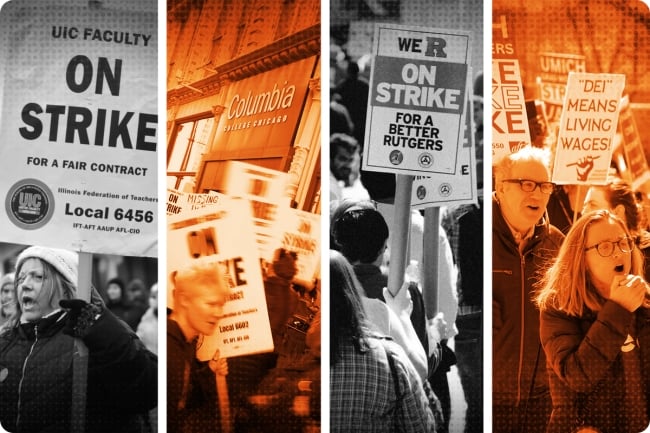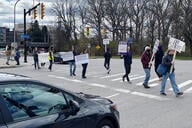You have /5 articles left.
Sign up for a free account or log in.

The past year has been a busy one for higher education labor actions and organizing.
A massive higher education labor action looms later this month. It could be just the start of another robust year of union organizing on campuses nationwide.
The California Faculty Association (CFA) and Teamsters skilled trades workers say they will begin a weeklong strike Jan. 22 at California State University, the nation’s largest public four-year university by enrollment. The CFA represents roughly 29,000 employees at CSU and the Teamsters a further 1,100.
In what may be an attempt to avert the strike, the 23-campus CSU announced Tuesday a 5 percent general salary increase, effective Jan. 31, for all instructional faculty members, librarians, counselors and coaches—the employees the CFA represents. In that same news release, the system said it’s done negotiating with the CFA, which has been pushing for a 12 percent increase this academic year.
“Throughout the bargaining process, the CFA never veered from its initial salary demand, which was not financially viable and would have resulted in massive cuts to campuses—including layoffs—that would have jeopardized the CSU’s educational mission,” the CSU release said.
Charles Toombs, the CFA’s president, said in an emailed statement Tuesday that “the CSU management bargaining team threatened systemwide layoffs, walked out of bargaining, canceled all remaining negotiations, then imposed a last, best and final offer on CFA members.” He said, “CSU management expressed nothing but disdain for faculty.”
“CSU management has never taken seriously our proposals for desperately needed equity transformation for CSU students, faculty, and staff, including raising base salary for our lowest-paid, struggling faculty, manageable workloads for more student engagement, more mental health services for students, limits to police power, and humane and adequate parental leave,” Toombs said.
A massive Golden State strike to kick off 2024 would echo the California strike that closed 2022, when unions representing 48,000 graduate assistants, readers, tutors, postdoctoral scholars and academic researchers struck across all 10 University of California campuses and the Lawrence Berkeley National Laboratory.
That strike, and the big one now in the offing at CSU, bookended 2023, which was itself a historic year for higher education unions. They saw swelling ranks, unprecedented strikes and major contract victories.
Chicago got things started in 2023 with a weeklong faculty strike in January at the University of Illinois at Chicago. And the Windy City closed the year with the month-and-a-half-long Columbia College Chicago part-time faculty strike.
That walkout, which ran from Oct. 30 into late December, was the longest contingent faculty member strike of at least the past decade, according to the National Center for the Study of Collective Bargaining in Higher Education and the Professions.
In April, Rutgers University saw its first faculty strike since its 1766 founding. That walkout also included lecturers, graduate student workers, postdoctoral associates and counselors, disrupting Rutgers’s New Brunswick, Camden and Newark, N.J., arms.
And there were even more Chicago and Illinois faculty strikes ongoing in April: at Chicago State University, at Governors State University on Chicago’s outskirts and at Eastern Illinois University, three hours south of the city. William A. Herbert, executive director of the collective bargaining center—which is at the City University of New York’s Hunter College—said the number of simultaneous faculty strikes was unheard-of in the past decade.
Temple University saw a graduate student worker strike begin Jan. 31 and last into mid-March. That heated walkout included the university temporarily cutting off strikers’ tuition remission and health coverage.
The strikes caused notable disruptions on several large campuses. University of Michigan graduate student instructors and staff assistants walked off the job March 29, not turning in students’ final grades for the semester and leading some department chairs to say they would just input A’s for some. Summer grad student instructors did teach and grade, but the fracas didn’t end until a tentative deal was struck a day before fall classes started in August.
Almost one-third of all higher education strikes in the past decade took place in 2022 and the first half of 2023, according to Herbert’s center, with the first half of 2023 being particularly active. The second half of 2023 added to the list the lengthy Columbia College Chicago walkout, a December postdoctoral researchers’ strike at the Icahn School of Medicine at Mount Sinai and a taste of something much bigger to come: one-day strikes at four CSU campuses.
“What we’re seeing is momentum—it’s momentum-based organizing and worker-led organizing,” said Brandon Mancilla, Region 9A director for the United Autoworkers, a major player in graduate student worker organizing. Mancilla himself was the first president of Harvard University’s UAW grad student union.
He said workers are reaching out to the UAW in large numbers, often with already-formed organizing committees. “Right now it’s just a moment where every single place you can think of, all of these academic workers are organizing,” he said.
The national number of specifically student worker bargaining units, including both undergraduate units and the much more common grad worker units, increased 54 percent just between January 2022 and July 2023, the National Center has reported. And in the last half of 2023, even more unionized, at Duke, Emory and Cornell Universities, among others.
“This is going to keep going for the foreseeable future,” Mancilla said.
‘Realizing Its Full Power’
Mancilla said the UAW now represents about 100,000 higher education workers. Though workers represented and the number of dues-paying members aren’t directly comparable figures, the number of dues-paying autoworkers in the UAW currently stands at around 150,000, he said.
The UAW’s ranks include the chapters at UC that walked off the job in late 2022. Rafael Jaime, president of the UAW local representing UC teaching assistants, tutors and readers, said, “The things that we won in our contract, I think, have really set the standard for every other higher education contract in the country.”
UC graduate student workers achieved new minimum pay, including $36,500 for teaching assistants on the Berkeley, San Francisco and Los Angeles campuses. According to Jaime, “we won raises of between 55 and 80 percent for the average graduate worker at the University of California.”
He said there were also nonfinancial wins, including harassment and discrimination protections meant to improve upon UC’s existing Title IX processes. Employees at other universities have since fought for increased protections in this area.
“It really raised expectations not only in terms of what we can do to demonstrate our power but also in terms of what we can win,” Jaime said. “Over the last year, I think the ground has shifted.”
In the next couple of months, he said, all three of UC’s UAW chapters that were involved in the 2022 strike will unify into one union representing 48,000 workers.
“I think higher education is finally realizing its full power,” Jaime said.
Mancilla agreed that strike and contract victories feed further union activity, causing higher education workers elsewhere to start talking and saying, “We want in on that.” He said these victories also mean top universities have to compete with one another on pay.
“Who’s going to want to be a Ph.D. at a place that still pays you $30,000?” he said.
But Mancilla traced what happened in 2023, and what’s continuing to happen, back longer than the UC strike. He traced the surge to 2016, when the National Labor Relations Board ruled that private universities’ graduate research and teaching assistants are entitled to collective bargaining under the National Labor Relations Act.
While UC and CSU are public universities, Mancilla said that after Harvard and Columbia grad workers unionized and went to the bargaining table, “it just became a domino effect across the industry.”
Jaime himself said organizing for the 2022 UC strike, including newly unionizing student researchers, began in 2018. Mancilla said that, alongside the changes at the NLRB, “worker-led organizing is what has allowed this to happen.” He said unions are forming not because the UAW initially sends staff out to universities, but because workers on campuses start organizing first and then request the UAW’s help.
And in this aspect, both men pointed to an external factor nationwide, but particularly acute in California: cost of living increases.
“There were plenty of workers who were facing homelessness due to the rising cost of living,” Jaime said.
Tobias Higbie, a professor of history and labor studies at the University of California, Los Angeles, and director of the UCLA Institute for Research on Labor and Employment, cited these same factors alongside young people being more engaged in unionization. But he took its origins back even further.
“I think the [UC] strike focused attention on the impacts of austerity on higher education, and that’s a long process,” Higbie said, going back to the ’90s nationally and the ’70s in California, when Proposition 13 limited property tax revenues.
He said grad students no longer look toward a career as a comfortable professor, “but instead as a precarious, nontenured faculty person, second-class citizen within the university, so it puts a different spin on your life as a graduate student.” Their contingent status becomes more of a permanent proposition.
Universities have increasingly employed grad students to do the work faculty members once did. Higbie said austerity has continued through the pandemic, and a poor academic job market means grad students are less likely to move into tenured positions. But unionization is a way for them to increase their job protections and benefits without that.
“Those trends can carry on for many decades, as they have, and it’s only been recently that we’re starting to see much more militant action,” Higbie said. Specific to California, he said, “A lot of people who work in the CSU system have UC Ph.D.s” and were once part of the UAW at UC themselves. That now includes experience in striking.
“That’s really how you create a movement,” he said.




